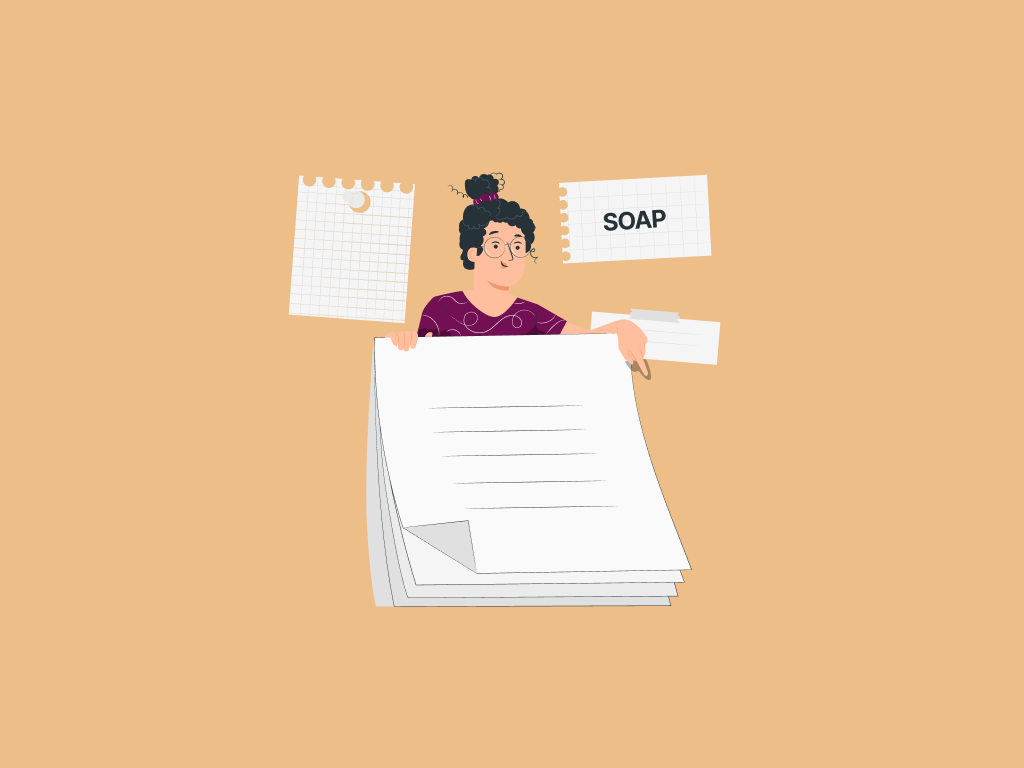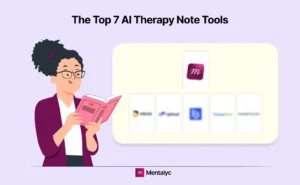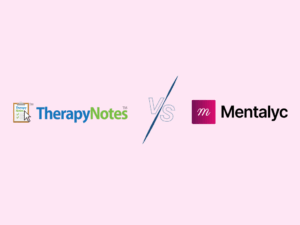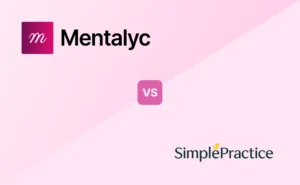As a mental health professional, do you struggle to keep track of your client’s treatment progress? Do you have difficulty remembering the details of your last session when a client asks about their progress? Look no further than SOAP notes! They are the perfect solution to your documentation woes. SOAP notes provide a quick and systematic way to record your client’s treatment, refresh your memory about past sessions, and facilitate seamless collaboration with colleagues.
In this comprehensive blog post, we’ll unravel the mysteries of SOAP notes and equip you with the best SOAP note template and examples and everything you need to know. From their purpose to their importance and best practices, we’ll dive deep into the world of SOAP notes, demystifying jargon. By the end, you’ll produce SOAP notes quicker than ever and wonder how you managed without them. Whether you’re a seasoned therapist or a new counselor just starting, SOAP notes are essential for elevating your documentation to the next level.
But even with the best templates, writing SOAP notes can still take up valuable time after every session. That’s where Mentalyc comes in. The platform transforms your session conversations into structured SOAP notes automatically – complete with subjective, objective, assessment, and plan sections. This means you can document progress instantly, keep treatment aligned with goals, and always be ready for supervision, audits, or client questions.
So, fasten your seatbelt and prepare to explore the world of SOAP notes.
Why Are SOAP Notes Important for Mental Health Practitioners?
SOAP notes are an invaluable tool for mental health practitioners, providing a structured and efficient way to document a client’s treatment progress. But why exactly are SOAP notes so valuable? Let’s explore:
Organized and Systematic:
SOAP notes follow a standardized format, ensuring that all relevant information is documented consistently. This allows mental health practitioners to review and understand the client’s progress over time easily.
Enhanced Memory Recall:
With SOAP notes, there’s no scrambling to remember the details of previous sessions. The subjective section captures the client’s thoughts, feelings, and perceptions, while the objective section records concrete observations. This comprehensive documentation helps mental health professionals recall critical details and tailor their treatment approach accordingly.
Using SOAP notes with Mentalyc helps you quickly recall important details from past sessions. By organizing information clearly and consistently, the notes act like a quick memory boost. Mentalyc keeps track of the context from previous sessions, so you always know exactly where you are with each client and what to focus on next.
Collaborative Care:
SOAP notes facilitate seamless collaboration among colleagues. By sharing SOAP notes, mental health practitioners can ensure continuity of care and provide insights to other professionals involved in the client’s treatment. This collaborative approach enhances the quality of care and promotes effective interdisciplinary communication.
Evidence-Based Analysis:
The assessment section of SOAP notes is a crucial tool for mental health practitioners to analyze and interpret the subjective and objective information their clients provide. This evidence-based analysis establishes diagnoses, clinical impressions, and informed judgments about the client’s issues or conditions. It guides treatment decisions and ensures interventions are based on sound clinical reasoning.
Goal-Oriented Planning:
One crucial section of the SOAP note is the plan section, which outlines the actions needed to address the client’s issues or conditions. The plan section comprises setting achievable goals, identifying interventions, making referrals, and determining the next steps. By documenting this plan, mental health practitioners can track their client’s progress, evaluate the effectiveness of interventions, and make necessary adjustments to achieve optimal outcomes.
Common Mistakes to Avoid When Writing SOAP Notes in Mental Health Practice
A few common mistakes to avoid when documenting your clients’ treatment plans:
Not Being Specific Enough.
Be as detailed as possible in your notes. Rather than writing “client discussed relationship issues,” it’s better to specify which issues were discussed and how the client felt. For example, “Client expressed frustration over lack of communication with a partner. Stated feeling unheard and underappreciated.”
Leaving out Important Details.
It’s easy to forget key details when you have a busy caseload, but your notes should capture the most important elements of each session. Note the client’s mood and affect, discussion themes, interventions used, goals set, and plans for the next session. Avoid ambiguity in your notes to ensure you can easily refer to them.
Failing to Record the Client’s Direct Quotes.
When possible, record the client’s exact words and phrases as they provide valuable context and insight into their thoughts, feelings, and behaviors. Quote important statements about their symptoms, experiences, goals, and challenges.
With Mentalyc, you don’t have to worry about jotting down quotes or important client statements during sessions. Mentalyc automatically captures and organizes them seamlessly in the background, so you can stay fully present with your client without missing a thing. This way, your notes are richer and more accurate – without any extra effort on your part.
Missing the “So What?”
Your notes should analyze themes, assess progress, discuss interventions, and reflect your clinical reasoning. Explain the significance of conversations, events, and any changes to the treatment plan.
How to Generate Effective SOAP Notes for Therapists (With Examples)
SOAP notes are the bread and butter of healthcare documentation, and for clinicians, writing concise yet comprehensive notes is essential. The most efficient way to do this is with Mentalyc – an AI-powered tool that transforms your session recordings into clear, structured SOAP notes in minutes, ensuring accuracy, compliance, and consistency without the extra workload.
Here are some additional tips for crafting clear SOAP notes:
Focus on One Client Issue per Note.
Avoid cramming multiple concerns into a single note, or it will become confusing.
Focus on the Subjective.
This is where you document the client’s symptoms, behaviors, experiences, or life events since the last session. Ask open-ended questions to get details about intensity, frequency, and duration.
For example:
“Client reports feeling increasingly depressed over the past week with trouble sleeping, loss of appetite, and difficulty concentrating at work. States sadness is 8 out of 10 in intensity, occurring daily, and lasting most of the day.”
Objectively Observe.
Note factual observations of the client’s appearance, mood, affect, speech, and behavior, and avoid opinions or judgments.
For example:
“Client made little eye contact, slouched in their chair, and spoke softly. Appeared tired with flat affect.”
Assess the Analysis
This is your chance to analyze subjective and objective data, provide a diagnosis or differential diagnosis, and evaluate any risks or contributing factors.
For example:
“Symptoms appear consistent with major depressive disorder, recurrent episodes. There are no apparent safety risks at this time. Stress at work and relationship difficulties likely contributing factors.”
Plan the Intervention
Explain the plan for treatment, including goals, interventions, frequency of sessions, referrals to other professionals, and any follow-up needed.
For example:
- Provide empathy, support, and coping strategies to improve mood and functioning.
- Discuss starting antidepressant medication to elevate mood.
- Increase sessions to twice weekly for the next month
- Follow up with psychiatrist regarding medication management.
- Develop a self-care plan to improve sleep, appetite, and daily activity.
SOAP Note Example and Template for Mental Health Progress Notes
Let’s examine how to combine the SOAP note components using the SOAP format:
As a psychotherapist, therapist, or counselor, it is crucial to take comprehensive SOAP notes that document your client’s mental and emotional state throughout their therapy sessions. For streamlined, structured documentation, you can explore tools that support a consistent approach to client progress. Additionally, record any changes in their symptoms, progress, or setbacks in their therapy journey
Some examples include:
SOAP Note Example and Template for Psychotherapists
S (Subjective): The client reported feeling “stressed out” and “overwhelmed.” Stated, “I’ve been worrying constantly and can’t relax.” Reported trouble sleeping for the past week.
O (Objective): The client exhibited signs of anxiety, including rapid speech, leg shaking, and difficulty maintaining eye contact. Apologized frequently for “rambling.”
A (Assessment): Anxiety. Insomnia related to excessive worrying/stress.
P (Plan): Discussed relaxation and mindfulness techniques for anxiety management. Recommended limiting screen time and stressful activities before bed. Will follow up in two weeks.
SOAP Note Example and Template for Therapists
S: The client reported experiencing high stress levels and feeling “crushed” over the past week. States trouble sleeping, concentrating, and increased anxiety.
O: The client presented as restless and fidgety. Speech rapid. Affect mildly anxious. Insight and judgment intact.
A: Anxiety related to increased work responsibilities and deadlines. Stress and worry cause difficulty regulating emotions and focus.
P: Discussed stress management and relaxation techniques such as controlled breathing, meditation, and limiting caffeine/screen time before bed. Referred client to online anxiety coping strategies and recommended decreasing workload if possible and planning enjoyable activities. Follow up in two weeks.
SOAP Note Example and Template for Counselors in Behavioral Health Settings
S: The client states, “I’ve been struggling” with a depressed mood for the past month. Endorses feelings of hopelessness, low energy, and changes in sleep and appetite—no suicidal ideation.
O: Appearance disheveled. Psychomotor impairment is evident. Speech slowed. Affect depressed and tearful at times. Insight is good, and judgment is intact.
A: Major Depressive Disorder, recurrent episodes, moderate.
P: Discussed therapeutic options of medications and therapy. Therapist recommended seeing a psychiatrist for medication evaluation and follow-up with therapy and referred them to community support groups. Safety plan established. Follow up in one week.
SOAP Note Example and Template for Social Workers
Social workers emphasize documenting environmental and social factors related to their clients in SOAP notes. For instance, these notes outline the client’s living arrangements, family and social connections, and access to resources that may improve their overall well-being.
For example:
S: The client reported ongoing conflict with a neighbor regarding noise complaints, causing distress. States the situation has led to anger, frustration, and hopelessness.
O: The client was irritable during the interview but was cooperative—no evidence of dangerousness to self or others.
A: Stress and impaired coping related to interpersonal conflict and environmental issues.
P: Discussed conflict resolution strategies and options for improving the situation, including neighbor mediation. Referred client to the local housing authority regarding options for moving away from conflict. Will see the client again in two weeks to reassess coping and check on progress with mediation/housing options.
S: The client says they are having trouble paying rent and buying food this month and are expressing frustration over the lack of family support.
O: The client was petulant but maintained an agreeable attitude throughout. No evidence of substance abuse. Living in subsidized housing and receiving food stamps.
A: The client is in a financial crisis due to losing a part-time job. Lack of financial literacy and family support system are contributing factors.
P: Refer the client to a job placement program and financial counselor. Help apply for additional food stamps and utility assistance. Follow up on job and financial counseling progress.
SOAP Note Example and Template for Psychiatrists
Psychiatrist SOAP notes will primarily concentrate on the medical aspects of their treatment plan, such as the management of their medication regimen. This includes details on the medications prescribed, their dosages, and the client’s response to medication. It also involves tracking any side effects that the client may experience, as well as any adjustments made to their medication regimen in response to changes in their condition.
Examples include:
S: The client reported medication is stabilizing mood; however, continues to struggle with the side effects of sedation and weight gain. Stated mood has been “okay,” but motivation and energy remain low.
O: Psych exam within normal limits. No suicidal or homocidal ideation. Weight gain of 10 lbs since last visit, possibly related to medication.
A: Bipolar I disorder, current episode depressed. Improved with medication but suboptimal response due to side effects.
P: Discussed options for switching or augmenting medications to address residual symptoms better while minimizing side effects. Will start the client on Wellbutrin 150 mg in the AM in addition to current meds. Follow up in four weeks to reassess symptoms, medication effects/side effects, and functioning.
S: The client reports feeling increasingly depressed and anxious over the past month, with trouble sleeping, poor concentration, and loss of interest in activities. Claims relationship issues and work stress are contributing factors.
O: The client appears disheveled and fatigued. Speech is coherent but slowed. Mood is dysphoric, and affect is constricted. No evidence of psychosis or suicidal ideation.
A: Major depressive disorder, recurrent, moderate. Generalized anxiety disorder.
P: Continue current medications (Lexapro 20mg, Buspirone 15mg) with follow-up in four weeks. Recommended beginning weekly psychotherapy to address contributing stressors and coping strategies. Encouraged regular exercise, limiting alcohol/caffeine intake, and maintaining a routine sleep schedule. Will re-evaluate symptoms and medications at the next visit. Instructed client to call if symptoms worsen or side effects develop.
Some more templates and examples…..
Whether you’re a nurse responsible for keeping patients comfortable, an occupational therapist (OT) helping clients live independently, or a speech-language therapist (SLP) supporting communication, you must create precise and tailored SOAP notes to document your patients’ progress. To do this, focus on subjective reports, objective observations, assessments matching your scope of practice, and practical plans for helping your patients.
To help you get started, consider using tools that can assist in generating automated SOAP notes or here are some examples to guide you:
SOAP Note Example and Template for Nurses in Psychiatric Nursing Documentation
S: Patient reports increased pain in the lower back, rating 7/10. The patient appears uncomfortable.
O: Lower back tenderness to palpation. Pain worsens with movement. Vital signs stable.
A: Acute exacerbation of chronic lower back pain.
P: Administer Ibuprofen 600 mg PO. Apply a heating pad to the lower back. Refer to the physician if pain persists for more than three days.
S: Patient complains of pain and difficulty walking due to recent knee surgery.
O: Knee incision site is healing well, with no sign of infection. The patient can bend their knee 30 degrees. Leg muscles feel weak when walking.
A: Impaired mobility and muscle weakness related to knee surgery.
P: Assist patient with walking and knee exercises. Provide pain medication as needed. Re-evaluate mobility and pain in two days.
SOAP Note Example and Template for Occupational Therapists
S: Patient reports difficulty grooming and dressing due to a decreased range of motion in the dominant right arm.
O: Active range of motion in right shoulder flexion limited to 90 degrees. Grip strength 4/5.
A: Impaired range of motion and strength in the right arm, limiting independence with self-care.
P: Recommend continued home exercise program. Added towel stretch for their shoulder. Follow up in two weeks to reassess range of motion and strength.
S: Patient has decreased range of motion and strength in dominant right hand after elbow fracture. Has difficulty with activities of daily living like eating, bathing, and dressing.
O: Grip strength measures 10 lbs in their right hand compared to 35 lbs in their left hand. Right wrist extension limited to 15 degrees.
A: Limited mobility and dexterity impairing independence.
P: Provided hand exercises to improve range of motion and strength. Recommend using adaptive equipment like button hooks, jar openers, and utensil holders to assist with activities of daily living. Follow up in one week to reassess and provide additional recommendations as needed.
SOAP Note Example and Template for Speech Therapists
S: Patient exhibitied word-finding difficulties, prolonged pauses in conversation, and repetition of phrases.
O: Decreased verbal fluency noted on assessment—difficulty naming objects and generating lists.
A: Possible mild cognitive impairment or early dementia. Further assessment is needed.
P: Referred patient to a physician for neurological workup, including brain imaging. Provided patient and family education on communication strategies—schedule follow-up appointment pending physician findings.
S: Patient has difficulty speaking clearly due to muscle weakness from stroke. Speech is slurred and hard to understand.
O: Oral musculature appears uneven and drooping on the right side of the mouth. Tongue deviates to the right when protruded.
A: Dysarthria related to right-side facial and tongue muscle weakness.
P: Recommend speech therapy focusing on tongue and lip exercises to improve muscle tone and control. Provide communication strategies like speaking slowly, over-articulating words, and using gestures to supplement speech. Re-evaluate speech clarity in three weeks after therapy.
Are you ready to take your client documentation to the next level? With consistent practice, you’ll develop the skills to capture all the essential details that reflect your daily meaningful work helping your clients. Imagine reaching new heights in your organizational skills by keeping good records of your sessions and maintaining clear communication. Your clients and colleagues will thank you for producing clear, concise, valuable notes to help you make data-driven treatment decisions. With consistently high-quality notes, you’ll be able to identify trends and have records that will withstand the highest scrutiny. Remember, the key is to stick with it, use templates and examples, and develop a system. You can refer back to this guide anytime you need a refresher. Now go forth and document, and let your work positively impact your clients’ lives.
If you need motivation to dive into your documentation journey, try Mentalyc! Our platform is designed to help you maintain clear communication and stay organized so that you can focus on what matters most – providing top-notch care to your clients. With Mentalyc, you get more than just speedy note-taking. You get a versatile and adaptable platform to personalize your notes and use the language you and your team are most comfortable with. Our intuitive interface makes navigating through different sections easy and captures all the essential details of each session. Plus, with customizable templates and the ability to adapt the SOAP format to your needs, you can quickly create comprehensive yet concise notes. Say goodbye to the headache of note-taking and hello to the ease and convenience of Mentalyc. Join us today and revolutionize your note-taking process!
FAQ on SOAP Notes: Answering Common Questions From Mental Health Professionals
As a mental health professional, you may have questions about documenting client care with SOAP notes. Below are answers to some common questions that will make the process more straightforward.
Do SOAP notes need to be written in a particular format?
Although the layout can vary, SOAP notes should follow a consistent and logical format. The SOAP format is commonly used, but you can adapt it to best suit your needs. Most importantly, your notes are clear, concise, and chronological.
The SOAP format:
S: Subjective (client quotes, current symptoms)
O: Objective (mental status, observations)
A: Assessment (diagnosis, case conceptualization)
P: Plan (treatment, recommendations)
Should I use whole sentences or bullet points?
You can write your SOAP notes in complete sentences or bullet points format. Full sentences can provide more detailed and descriptive information, enhancing the flow of the session’s narrative. On the other hand, bullet points help list the essential topics of the conversation or the different steps of an intervention. It’s important to use a style that works best for you and the specifics of each note.
What tense should I write in?
Writing SOAP notes in the past tense is important as they document what occurred during the session. For instance, instead of writing “The client reports feeling anxious and stressed at work,” write “The client reported feeling anxious and stressed at work.” However, in the Plan section, where future actions and goals are discussed, you can write in the present or future tense.
How should I organize each section?
The Subjective and Objective sections typically flow chronologically to tell the story of what was discussed and observed during the session. The Assessment section can be organized by each issue discussed or by themes that connect problems. The Plan section is usually organized regarding short-term goals, long-term goals, interventions, referrals, and follow-up.
What if a session runs long or short? Do I need to modify the SOAP note?
The SOAP note should accurately reflect the care provided in each session, regardless of length. If a session runs shorter or longer, simply document what was covered and any recommendations or follow-up needed. The most important thing is that the SOAP note matches the actual session.
What if nothing significant happened in a session? Do I still need a SOAP note?
Yes, a SOAP note is required for every session, even if the session was uneventful. Briefly document the topics discussed, the client’s current symptoms or functioning, and any recommendations.
Do I need to use medical terminology?
Use terminology that you and other providers in your practice will understand. Explain any complex terms or abbreviations. The notes should be clear and concise while accurately representing the critical aspects of the session.
What if I make a mistake?
Making mistakes while writing SOAP notes is common; nobody is perfect. It’s a good idea to proofread your notes and double-check critical information, such as medication names or diagnoses, to reduce the chances of errors. If you notice any mistakes, draw a line through the incorrect information, initial and date it, and then write the correct information. Never scribble over or white out errors.
What if I don’t have a lot of details for the objective section?
Don’t worry if you only have one or two objective findings. The important thing is to document what you observed. You can state, “No new symptoms reported.”
SOAP notes are great because they provide a clear, organized way that help you track client progress, but beyond that, some note-taking tools like Mentalyc offers a variety of other templates you can easily customize to fit your unique style and workflow. No matter how you like to document or what your practice needs, you’ll find flexible options that help you stay on top of things and save time, so you can spend more energy with your clients and less on paperwork.
Resources:
- Compliancy Group. (2023, July 25).8 common clinical documentation mistakes. https://compliancy-group.com/common-clinical-documentation-mistakes/
- Miller, K. D. (2020, April 3).What are soap notes in Counseling? (+ examples). PositivePsychology.com. https://positivepsychology.com/soap-notes-counseling/
- Podder, V., Ghassemzade, S., & Lew, V. (2022, August 29).SOAP Notes. National Center for Biotechnology Information. https://www.ncbi.nlm.nih.gov/books/NBK482263/
Why other mental health professionals love Mentalyc

“It takes me less than 5 minutes to complete notes … it’s a huge time saver, a huge stress reliever.”
Licensed Marriage and Family Therapist

“Having Mentalyc take away some of the work from me has allowed me to be more present when I’m in session with clients … it took a lot of pressure off.”
LPC

“A lot of my clients love the functionality where I can send them a summary of what we addressed during the session, and they find it very helpful and enlightening.”
Therapist

“By the end of the day, usually by the end of the session, I have my documentation done. I have a thorough, comprehensive note … It’s just saving me hours every week.”
CDCII







